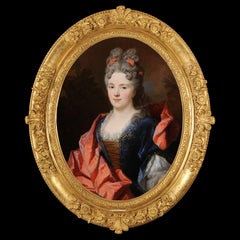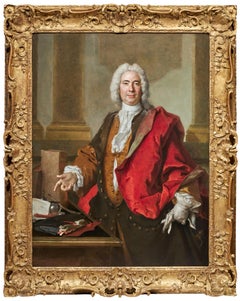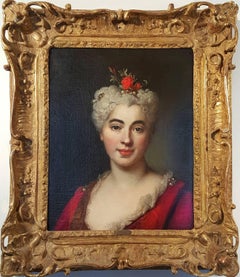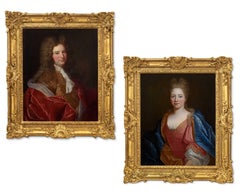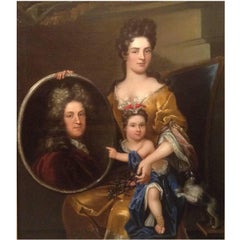Nicolas De Largilliere Art
French, 1656-1746
Nicolas de Largilliere (Paris, 1656-1746) Born in Paris, Nicolas de Largilliere spent his childhood in Antwerp. Trained there in the studio of Antoine Goubeau, who taught him the study from nature, Nicolas de Largillierre remained faithful to his precepts throughout his career. In 1673 he went to England where he worked as an assistant in the studio of the portrait painter Peter Lely for almost seven years. He was approved by the Royal Academy upon his return to France in 1683 and was received three years later as "painter of portraits and history"). The portrait is by far the genre that dominates an immense production of nearly 1,500 works produced in a workshop through which many renowned painters will pass. He is with Rigaud the most brilliant portraitist of the end of the XVIIth and the beginning of the XVIIIth century. Rigaud, however, is the official court portraitist, Largillierre works mainly for a wealthy bourgeois clientele. His work brilliantly illustrates the French high society under the reigns of Louis XIV and Louis XV, by an exceptional sense of observation he was able to render, sometimes without complacency, the individuality of the faces and the psychology of the characters.to
3
1
4
2
2
1
1
1
1
1
Presumed portrait of Marie-Anne de Bourbon
By Nicolas de Largillière
Located in BELEYMAS, FR
Nicolas de LARGILLIERRE
(Paris 1656 – 1746)
Portrait of a woman, presumed to be Marie-Anne de Bourbon, Princess of Conti (1666-1739)
Oil on oval canvas
H. 8...
Category
Early 1700s French School Nicolas De Largilliere Art
Materials
Canvas, Oil
Portrait of Monsieur Aubert, a ceremonial portrait by Nicolas de Largillière
By Nicolas de Largillière
Located in PARIS, FR
Provenance :
Arnold S. Kirkeby (1901-1962)
Donated by Arnold S. Kirkeby to the Los Angeles County Museum of Art in 1955, where it remained until its sale at Sotheby's, New York on January 10, 1991, lot 82.
Christie's, London, July 7, 2010, lot 186, where it was purchased after the sale by the executors of the will of the late Edmund de Rothschild (1916-2009) for display at Exbury House
The Trustees of Exbury House
Literature :
R. Brown, Bulletin of the Art Division, Los Angeles County Museum, VIII, 1957, pp.8-9, no. 4;
S. Schaefer and P. Husco, European Paintings and Sculpture in the Los Angeles County Museum of Art (Los Angeles, 1987), p. 53 (illustrated and dated c. 1735)
This sumptuous ceremonial portrait, executed around 1725-1730, depicts Monsieur Aubert, the French General Comptroller of Bridges and Roadways, as we learn from a letter on the desk beside our model. The virtuoso treatment of the fabrics, the authoritative yet confident pose, the vigorous treatment of the two hands, are representative of Largillière's talent, here at the peak of his art as portraitist.
The portrait also has a rather extraordinary provenance: donated by Arnold S. Kirkeby, an American hotel magnate and real estate developer, it was exhibited during almost forty years in the collections of the Los Angeles County Museum, before being acquired in 2010 by the executors of Edmund de Rothschild's will to adorn his former home Exbury House (Hampshire), where it remained until its sale in 2022.
1. Nicolas de Largillière, a great European portraitist
Nicolas de Largillière (or Largillierre), one of Europe's premier painters of portraits, history paintings, and still lifes during the late seventeenth century and the first four decades of the eighteenth, was born in Paris in 1656. He was the son of a hatmaker and merchant who moved with his family to Antwerp in 1659. As a boy of nine, he traveled for the first time to London in the company of an associate of his father. After returning to Antwerp more than a year later, his artistic gifts were recognized and his father apprenticed him to Antoni Goubau (1616-1698), a painter genre scenes and landscapes. Something of a prodigy, he was admitted to the painters' Guild of Saint Luke when he was only seventeen. In 1675 he made a second trip to London, where he was employed at Windsor Castle and worked as a restorer under the direction of Italian painter and decorator Antonio Verrio (c. 1639-1707), who brought him to the attention of King Charles II (r. 1660-1685).
At this time Largillière painted several still life paintings in the manner of the Dutch and Flemish masters. Thereafter he practiced this branch of painting with consummate skill, a talent that allowed him to make brilliant use of flowers, fruit, and animals in some of his most ambitious portraits and contemporary history pictures.
In 1679 Largillière settled in Paris, where he specialized in baroque portraiture in the grand manner of Peter Paul Rubens (1577-1640), Anthony van Dyck (1599-1641), and Peter Lely (1618-1680). The Flemish battle painter Adam Frans van der Meulen (1631 or 1632-1690) introduced him to Charles Le Brun (1619-1690) who, as First Painter to King Louis XIV (r. 1643-1715) and director of the Académie royale de peinture et de sculpture, was the predominant figure in France's official art establishment. Upon his acceptance as a candidate for admission to the Académie, he agreed to execute as his diploma picture a large portrait of Le Brun (completed 1686, Paris, Musée du Louvre, eight photo in the gallery) seated in his studio surrounded by the accoutrements of his art and an oil study for the ceiling of Galerie des Glaces at Versailles.
In 1686, Largillière made a final trip to England, where he painted portraits of the newly crowned king, James II (r. 1685-1688) (Greenwich, National Maritime Museum) and his consort Mary of Modena...
Category
1720s Old Masters Nicolas De Largilliere Art
Materials
Oil
Portrait Of Elisabeth Marguerite, The Artist's Daughter
By Nicolas de Largillière
Located in Miami, FL
Nicolas de Largillierre painted Elisabeth Marguerite in oil on canvas. A larger version of this work was offered by Sotheby's for $500,000 and is now in a French Museum - Palais ...
Category
18th Century and Earlier Rococo Nicolas De Largilliere Art
Materials
Canvas, Oil
Nicolas de Largillière - Portrait of a Lady, Paris, circa 1695
By Nicolas de Largillière
Located in PARIS, FR
Nicolas de Largillière (Paris, 1656-1746)
Portrait of a lady, circa 1695
Oil on canvas (relined): 76 x 61 cm
Framed: h. 97 cm, l. 82 cm
To be included in the forthcoming catalogue raisonné of the artist by Dominique Brême, director of museum of Sceaux and artist specialist.
Our work presents a majestic French aristocrat against the backdrop of a twilight landscape.
The face seen from the front, the body turned three-quarters, the young woman is portrayed half-length, revealing her slim belted waist.
The elongated face with rosy cheeks, almond-shaped eyes, straight nose and strong chin, solemn expression, the young woman sketches...
Category
1690s Old Masters Nicolas De Largilliere Art
Materials
Canvas, Oil
Related Items
Deposition Atala De Roussy-trioson Paint Oil on canvas 19/20th Century French
Located in Riva del Garda, IT
The deposition of Atala
Follower of Anne-Louis Girodet de Roussy-Trioson (Montargis, 1767 - Paris, 1824)
19th-20th century
Oil on canvas
47 x 65 cm. - Framed 67 x 84 cm
The propos...
Category
Late 19th Century Old Masters Nicolas De Largilliere Art
Materials
Oil
$2,106 Sale Price
20% Off
H 26.38 in W 33.08 in
Portrait Woman Princess Diziani Paint 18th Century Oil on canvas Old master Art
Located in Riva del Garda, IT
Gaspare Diziani (Belluno 1689 - Venice 1767)
Portrait of a Young Princess (Salome?)
Oil on canvas
42 x 33 cm
Framed 70 x 63 cm
A charming portrait of a beautiful young woman with ...
Category
18th Century Old Masters Nicolas De Largilliere Art
Materials
Oil
$6,845 Sale Price
20% Off
H 27.56 in W 24.81 in
1820's French Portrait of a Gentleman Signed & Dated 1824 Oil on Canvas
Located in Cirencester, Gloucestershire
Portrait of a French Gentleman
French School, indistinctly signed
dated 1824
inscribed verso
oil on canvas, unframed
painting: 22 x 19 inches
provenance: private collection, France
c...
Category
Early 19th Century Rococo Nicolas De Largilliere Art
Materials
Oil, Canvas
17th Century Italian Old Master Oil Painting Moses Striking Water from the Rock
By Pier (Pietro) Dandini
Located in Cirencester, Gloucestershire
Moses Striking Water from the Rock;
Circle of Pietro Dandini, Italian 1646-1712
Italian School, late 17th century
oil on canvas, framed
framed: 3...
Category
Early 18th Century Old Masters Nicolas De Largilliere Art
Materials
Canvas, Oil
$8,515
H 32 in W 28 in D 1 in
Figures Chatting outside Village Tavern in Mountain Landscape, Period Oil
By 19th century Dutch or Flemish school
Located in Cirencester, Gloucestershire
Dutch/ Flemish School, early 1800's
oil on canvas, framed
framed: 19 x 24 inches
canvas: 13.5 x 18.5 inches
provenance: private collection, France
condition: good and sound condition...
Category
Early 19th Century Old Masters Nicolas De Largilliere Art
Materials
Oil, Canvas
large 18th century portrait gentleman oil on canvas
Located in York, GB
A fine, imposing 18th century portrait of an unknown aristocrat,housed in a gilt frame
The artist is also unidentified but certainly a talented hand, in the circle of one of the fine old masters of the period. Unsigned
The size overall is 148 x 121 cm whilst the painting is 128 x 101 cm
In overall good condition the frame at the bottom has bowed slightly
The painting has been checked whilst being cleaned and has not been affected in any way .
SHIPPING
Free delivery to mainland uk ,worldwide shipping available please email for quote
Delivery usually within 14 working days, insured
please provide telephone/email details for courier.
All taxes/customs etc to be paid for by purchaser.
RETURNS (The Consumer Contracts Regulations) Whilst we are sure that you will be extremely happy with your purchase,
if for any reason you are not, then you are entitled to return the item to us for a refund.
For all purchases made
you are entitled to return the item(s) for a period of up to 14 days
following receipt by you or a representative indicated by you.
Please contact us to confirm that you are returning the item(s)
and the reason for doing so.
Upon receipt of the item(s) we will refund the purchase price via your original payment method...
Category
18th Century Old Masters Nicolas De Largilliere Art
Materials
Oil
$7,493 Sale Price
44% Off
H 58.27 in W 47.64 in D 2.37 in
Oil Portrait of a Victorian Lady, c. 1850
Located in Chicago, IL
Painted in the 19th century, this exquisite miniature portrait wonderfully exemplifies realism in traditional oil painting. The small artwork is painted in the conventional portraiture style of the Old Masters, and achieves soft realism with fine brushwork and a subdued, neutral palette. The half length portrait depicts a fine Victorian woman dressed in all black with a delicate lace collar and bonnet. She wears a ruby broach...
Category
Mid-19th Century Old Masters Nicolas De Largilliere Art
Materials
Oil
Portrait of a Young Man with Bagpipes, Follower of J.H. Tischbein the Elder
By Johann Heinrich Tischbein the Elder
Located in Stockholm, SE
Follower of Johann Heinrich Tischbein the Elder (1722–1789)
Man with Bagpipes
oil on oak panel
no signature
25 × 19 cm (9.8 × 7.5 in)
31 x 26 cm (12.2 x 10.2 in)
This refined 18th...
Category
18th Century Rococo Nicolas De Largilliere Art
Materials
Oak, Oil, Wood Panel
$4,188
H 12.21 in W 10.24 in
Madonna Parrot Paint Oil on table Old master Flemish Follower Master of Parrot
Located in Riva del Garda, IT
'Master of the parrot' (a painter active in Antwerp in the early 16th century, whose name refers to the parrot who always occurs in his paintings) - follower of
Madonna on the throne with child
(With the coat of arms of the client family in the upper part of the composition)
Oil on the table
101 x 62 cm. - In frame 114 x 76 cm.
The beautiful proposed work explains the typical iconographic characters of the painter called 'Master of the parrot', a conventional name used by critics to define an anonymous Dutch author of the 16th century.
More precisely, it is a painter of the southern Netherlands, active in Antwerp around 1530-50, so defined for the unmistakable parrot who often appears in his works of him. In religious iconography the parrot has often been used as a Marian symbol, as it was widespread that its most common verse was "Ave", that is, the greeting of the Archangel Gabriele to Mary at the time of the Annunciation.
Today the idea according to which the name 'master of the parrot' has not referred to a single painter, but rather a group that, based on the stylistic characters, carried out their training at the workshop of Pieter Coecke Van Aelst (Aalst (Aalst is widespread. 1502 - Brussels 1550), creating devotion paintings intended for a bourgeois client and concentrating their activity on a specific topic particularly requested by the contemporary market.
By way of example we can mention the Virgin with the San Diego Museum of Art child where the figures, like our own, are in line, With the mannerist taste for the elegant body proportions that exceed reality, with elements such as tapered finger, wide face and thin nose. These characters also betray the influence of active artists in the region such as Joos Van Cleve...
Category
17th Century Old Masters Nicolas De Largilliere Art
Materials
Oil
$12,975 Sale Price
40% Off
H 44.89 in W 29.93 in
Antique Roman painter - 18th century landscape painting - Wanderers - Italy
Located in Varmo, IT
Roman painter (18th century) - Landscape with Wayfarers.
43.5 x 34.5 cm unframed, 58.5 x 49.5 cm with frame.
Ancient oil painting on canvas, in a carved and gilded wooden frame (no...
Category
Early 18th Century Old Masters Nicolas De Largilliere Art
Materials
Canvas, Oil
$1,196 Sale Price
44% Off
H 23.04 in W 19.49 in
Antique French/ Italian Oil Painting Portrait of a Uniformed Brass Musician
Located in Cirencester, Gloucestershire
The Brass Band Musician
19th Century, French/ Italian School
signed oil on canvas mounted board, framed
framed: 19 x 15 inches
board: 14 x 10.5 inches
Provenance: private collection...
Category
19th Century French School Nicolas De Largilliere Art
Materials
Oil
Antique portrait oil painting of an art lesson by Swiss artist Louis Patru
Located in AIGNAN, FR
Antique portrait painting of two woman having an art lesson by Swiss artist, Louis Patru (1871-1905). This is an unusual painting from an artist who only enjoyed a short life. Two ...
Category
1890s French School Nicolas De Largilliere Art
Materials
Oil
Previously Available Items
Portrait of a Lady and Portrait of Gentleman, Velvet & Silk Attire c.1700 French
By Nicolas de Largillière
Located in London, GB
These lavish portraits, presented by Titan Fine Art, illustrate the elegant and exuberant type of portrait that the French court and the bourgeoisie favoured at the end of the 17th century. Painted circa 1700, they combine a meticulous representation of the subject's face and rich detailed draperies. They are a mastery of colour and of a style perfected by the prestigious painter and Director of the Académie Royale de Peinture et de Sculpture in Paris, Nicolas de Largilliere.
France during this period was the leading exponent of fashion and the arts to the rest of Europe and the fashions arose from the French court itself – and this is evident in the clothing on display in these portraits. The gentleman has been depicted in a russet coat with golden thread embroidery, a white lace cravat, and a rich crimson velvet mantle, that has been deliberately turned over at the top to reveal its purple shot silk lining. The young beautiful lady, whose face is painted with a clear and fresh palette, wears a dress with golden embroidery on the bodice and a huge black diamond brooch, large balloon-like gathered sleeves with lace and tied with a string of pearls, and a luxurious azure blue velvet mantle, tied at the shoulder with a pearl and large diamond brooch, again, deliberately folded to reveal its real gold embroidered lining. Her cheeks are rosy, with red lips: a style in keeping with that was worn at Versailles. The copious number of expensive fabrics, that completely encircle them, serve to underline their social status.
The skilful works, with their beautiful colour combinations, create a strong visual impact. The artist demonstrates great skill in the rendering of sumptuous fabrics, the use of vibrant colours, and the realism of the faces.
The couple are most likely married, considering the conventions of portraiture at the time, where the male is positioned on the left (and inclined to our right) and the female is positioned on the right (and included to our left).
A feature of these portraits are the stunning original carved and gilded frames – they are works of art in their own right.
Nicolas de Largillierre was baptised in Paris in 1656. His family relocated to Antwerp when he was approximately three years old. After a journey to London, Largillière's father arranged for him to apprentice with the Flemish artist Anton Goubau. Nevertheless, he departed at the age of eighteen and returned to England, where he formed a friendship and was employed by Sir Peter Lely for four years in Windsor, Berkshire. During this period, Largillière also worked under the guidance of the Italian painter Antonio Verrio.
His artwork garnered the interest of Charles II, who desired to keep Largillière in his service; however, he eventually returned to Paris, where he was warmly embraced by the public as a painter.
Upon his ascension to the throne in 1685, James II summoned Largillière back to England and offered him the position of keeper of the royal collections. He subsequently painted portraits of the king, Queen Mary of Modena...
Category
17th Century Old Masters Nicolas De Largilliere Art
Materials
Canvas, Oil
H 41.74 in W 35.83 in D 3.75 in
Late 17th century French Portrait of a Family Group
By Nicolas de Largillière
Located in Bath, Somerset
Studio of Nicolas de Largilliere (1656-1746). Portrait of a family. The lady, seated, wearing a gold coloured gown holding an oval portrait of her...
Category
Late 17th Century Baroque Nicolas De Largilliere Art
Materials
Oil, Canvas
H 57.88 in W 51.19 in
Nicolas De Largilliere art for sale on 1stDibs.
Find a wide variety of authentic Nicolas De Largilliere art available for sale on 1stDibs. You can also browse by medium to find art by Nicolas De Largilliere in oil paint, paint, canvas and more. Much of the original work by this artist or collective was created during the 18th century and earlier and is mostly associated with the Old Masters style. Not every interior allows for large Nicolas De Largilliere art, so small editions measuring 15 inches across are available. Customers who are interested in this artist might also find the work of Charles Zacharie Landelle, Achille-Émile Othon Friesz, and Paul Emile Léon Perboyre. Nicolas De Largilliere art prices can differ depending upon medium, time period and other attributes. On 1stDibs, the price for these items starts at $55,522 and tops out at $160,000, while the average work can sell for $95,000.
